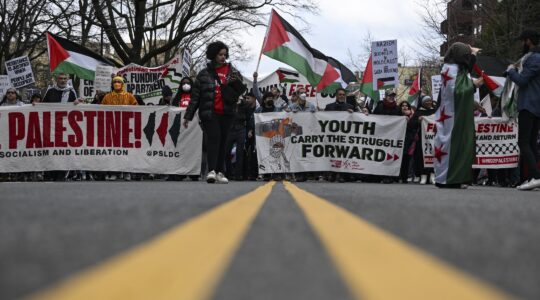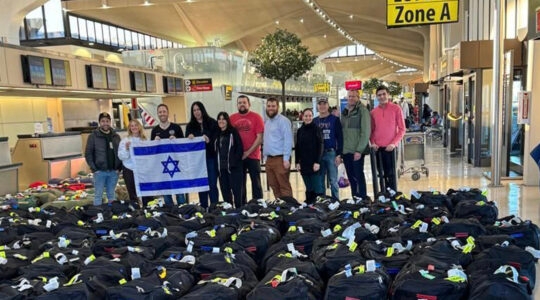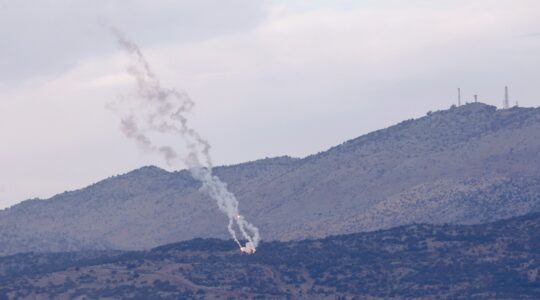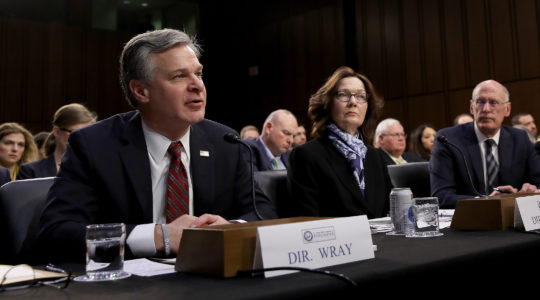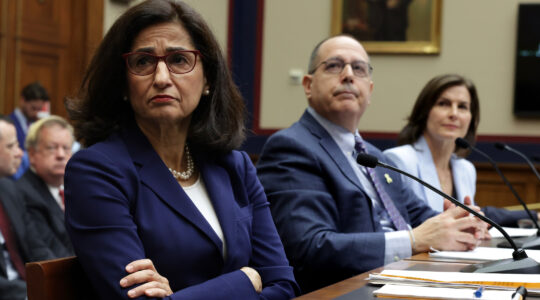EDISON, N.J. (JTA) – Rochelle Lichtman carefully lifts the head of the woman lying prone on a table in front of the room, while Karen Richter places a fresh piece of white cotton over her face.
Lichtman then eases a white bonnet over the woman’s head, tucking in the edges of the face covering. She winds the bonnet’s strings under the chin and back up to the top of the head, where she ties the ends to form the Hebrew letter “shin,” representing one of the names of God.
Lichtman and Richter volunteer for a chevra kadisha, or burial society, in Winnipeg, Canada. They are part of a four-woman team that has come to this week’s North American Chevra Kadisha Conference to demonstrate the taharah ritual – washing a newly deceased body according to Jewish tradition before it is dressed in a white shroud and buried in a plain wooden box.
Their model for the purification rite is very much alive – her face covering is moved at one point to ease her breathing. But the care and respect the team demonstrates during its two-hour session is as real as if the members are working on one who has passed away.
“I wasn’t sure I could do it,” says another member of the team, Evita Smordin, talking about the first time she was asked to take part in a taharah. “Now I feel it’s a real honor. It’s the only thing you do for a person that they can’t pay you back for.”
Taharah and other Jewish burial customs fell out of favor in liberal Jewish circles during the 20th century, as increasing numbers of Jews adopted American fashions of embalming or even cremation, which goes against Jewish law.
Now as more liberal Jews are re-examining such rituals as keeping kosher and Shabbat, the chevra kadisha is also making a comeback. And a new institute set to open in the fall of 2009 will offer what organizers say is the country’s only certified program in Jewish end-of-life practices.
While it is one thing to rhapsodize about the beauty of caring for the deceased, it is quite another to find volunteers who literally must touch death. That’s typically left to hospitals and mortuaries.
The work of the chevra kadisha is shrouded in mystery. Traditionally, even the names of those who perform the work are kept secret to preserve the dignity of the departed.
And there are few hard-and-fast rules. Beyond certain basics, the actual steps of cleaning and dressing vary from community to community. Thus if no “elders” are available to teach a new generation, volunteers must use books and common sense.
When the small Jewish community of Fort Collins, Colo., organized its burial society, members consulted many instruction manuals in developing their own ground rules.
Given the difficulties, it may seem surprising that burial societies are starting up at more and more synagogues and in Jewish communities across North America.
Several dozen were represented at the sixth annual conference Sunday to Tuesday. It was co-sponsored by the National Association of Jewish Chaplains and Kavod v’Nichum, a group that provides training and resources for the burial societies and bereavement committees.
David Zinner, the executive director of Kavod v’Nichum, cannot quantify the growth of burial societies, but says he sees more conference participants each year and is receiving more inquiries on setting up the societies.
As part of its efforts to increase awareness of and expertise in traditional Jewish burial and bereavement, Kavod v’Nichum is launching the Gamliel Institute, a center for the study, training and advocacy of Jewish end-of-life practices.
The institute will offer a three-year certification program aimed at chevra kadisha volunteers, rabbis, chaplains, funeral directors and other Jewish communal professionals.
Organizers say the goal is to produce a cadre of trained advocates who will encourage Jewish communities to integrate death and mourning into the Jewish life cycle instead of marginalizing and neglecting them.
“This will take what we’ve been doing for the last six years at these conferences and turn it into an in-depth, comprehensive way of looking at the entire continuum from critical illness through death and mourning,” says Zinner, who will co-direct the new institute with Rabbi Stuart Kelman of Berkeley, Calif.
Many of the volunteers at the conference spoke about the emotional toll of their work, as well as the spiritual satisfaction.
Reba Herzfeld of Atlanta described the “chevra huddle” her women’s burial group does after each ritual cleansing.
“We put our arms around each other, we say a prayer, someone says something nice about the woman,” Herzfeld says. “Even if we didn’t know her, we talk about how she was somebody’s daughter, wife, mother, something to send her soul peacefully to the next world.”
Herzfeld’s grandmother and mother both served on burial societies in Atlanta, but it “was something you didn’t talk about when I was growing up in the ‘50s,” she said.
It was only when she saw a friend’s 16-year-old son taken off a respirator 12 years ago that she “found the strength,” she says, to help organize one of the first Reform synagogue-based burial societies in the country.
Noting that three Reform synagogues in Atlanta now have burial societies, Herzfeld says the field is growing fast.
“I get a lot of soul satisfaction from this,” she says.
Getting younger volunteers is another challenge.
Risa Hanau, 42, says she is the youngest member of her Conservative synagogue’s chevra kadisha in Greensboro, N.C.
“A lot of the younger women are mothers, and their focus is on youth, the start of life,” she explains. “Also, it tends to be older people because they want to feel that someone will do it for them.”
In an effort to draw in younger congregants, her burial society is encouraging them to volunteer first for shmira, the round-the-clock guarding of the body as it awaits burial.
Rabbi Susan Tendler of Congregation Beth El, a Conservative synagogue in Norfolk, Va., ran an educational session on her congregation’s chevra kadisha last fall, specifically targeting younger congregants. Fifty people showed up.
“There’s an opportunity there to start getting younger people,” says Tendler, who is in her late 30s.
As new burial societies organize themselves, they often find themselves making decisions that raise questions of Jewish tradition, even Jewish law. What if a family wants a taharah, but the burial society knows the deceased will be cremated? Should a burial society perform a taharah on a non-Jew if the Jewish spouse requests it?
It’s up to each society, even each individual member, to decide.
The burial society in Los Alamos, N.M., polled its members on some of these questions, according to one of its members, Rick Light. Four said they would do a taharah before a cremation; eight said they would not. One said he would not do a taharah on a non-Jew, while five said they would as long as Jewish prayers were not said.
These decisions must be conveyed to the bereaved family.
“You’re walking a tightrope,” Light says. “You don’t want to offend people. It’s a very emotional topic.”
